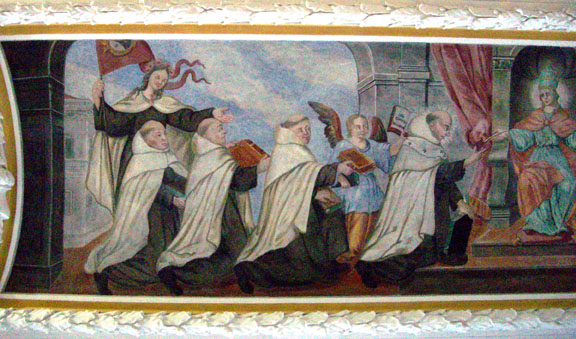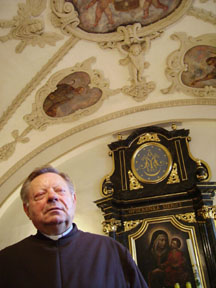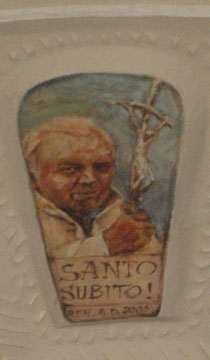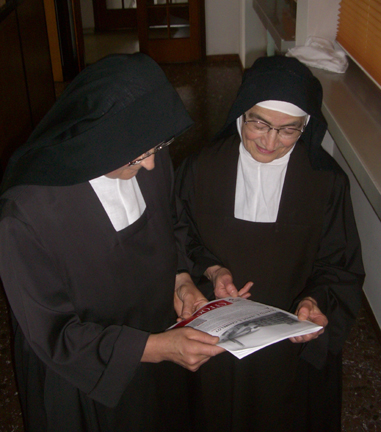|
no. 3 july - september 2007
Rare Carmelite Book of Hours Obtained A rare fifteenth century illuminated Book of Hours was obtained by the Carmelitana Library of the PCM Province at an auction in Sotheby’s in London. The pocket-sized book (111mm by 87mm) contains 242 leaves which is probably about 20 less than the book originally contained. The auction house of Sotheby described the book as "book of hours and prayer book of Carmelite use, in Latin, illuminated manuscript on vellum." The litany contains many German saints as well as Carmelite ones. The liturgical calendar includes St. Erhard, Kunegund, Heinrich, and Boniface among others. The origins of the book are unknown. Based on its style of script and illumination, it was probably compiled in France in the late 1400s. The text is in dark brown ink with headings in red and enlarged initials of various sizes are in dark red, blue, and gold on panels with delicate tracery in white and gold. The borders are formed of colored flowers and acanthus leaves on partly colored liquid gold grounds with daisies, strawberries, birds, as well as other objects. The book also contains on March 15th, the feast of St. Longinus, whose lance pierced Christ’s side, a feast that was introduced in 1480, St. Martial of Limoges, a Carmelite feast on July 7 which was introduced in 1339, and the 11,000 Virgins, celebrated on October 21 after its introduction into the Carmelite liturgy in 1339. The book also contains the Penitential Psalms and Litany of Saints, including the prophet Elisha, and Saints Martial, Kylian, Edmund, Sigismund, Angelus of Jerusalem, and Albert of Sicily. Among the prayers are the Joys of the Virgin, reputedly composed by St. Thomas à Becket and prayers on the relics of the Holy Lance and the Crown of Thorns, the veneration of which were elevated to Carmelite feasts in 1488. Such books are very rare. This copy came from an owner in Wellington, New Zealand. Adapted from an article by David Waite, O. Carm., in the Spring 2007 (41 no. 1) bulletin of the British Province. Two pages from the 15th century illuminated Carmelite Book of Hours.
Celebration of the Life of Italian Bishop Francisco Raiti, O. Carm. On March 3, 2007, the 75 th anniversary of his death, the City of Linguaglossa wanted to solemnly honor one of its most revered citizens, Francesco M. Raiti (1864-1932), Bishop of Trapani, Carmelite, and zealous pastor.In the Council Room of the City Hall, in the presence of the mayor, of the Archbishop of Acrieale, and of the Archbishop of Trapani, a group of the illustrious bishop’s relatives, many citizens, and representatives of various religious groups came together. Talks intending to illustrate the Carmelite as a zealous pastor were given by Emanuele Boaga, O. Carm., instructor at the Marianum in Rome, and by Bishop Gaetano Zito, Episcopal Vicar of the Diocese of Catania and instructor at the Studio Teologico S. Paolo in Catania. From the presentations emerged the picture of a man of deep prayer, of great culture, and of creativity. He was called "Father of Charity": all of his life was an unceasing hymn of charity and good works, in a continuous reference back to the Gospel. The session concluded with some testimonials to the bishop. At the end was the declaration of the Linguaglossa City Government that a city square be named for the Carmelite bishop, as a place of meeting and of socialization dedicated to the teaching of this figure, example and model of faith, Apostle of hope, and champion of charity.
Beatification of the Catalonian Martyrs The Vatican has announced that the beatification of Carmelite Servant of God Àngel Maria Prat Hostench and his 16 Companions will take place at St. Paul Outside the Walls, Rome, on October 28, 2007. These Carmelites fell victim to the hatred of the Christian faith during the religious persecution during the Spanish Civil War in the 1930’s. It is estimated that over 1 million from all ages and social classes—bishops, priests, both male and female religious and laity—were killed. In addition to the Servant of God Prat Hostench, those Carmelites being beatified are Eliseo María Maneus Besalduch, Anastasi María Dorca Coromina, Eduardus María Serrano Buj, all of whom were priests. The group also includes professed students Pere María Ferrer Marín, Andreu María Solé Rovira, Miguel María Soler Sala, Joan María Puigmitjà Rubió, Joan María Prat Colldecarrera, Eliseu María Fontdecava Quiroga, and two novices Joseph María Escoto Ruiz, and Elias María Garre Egea. They all died on July 28, 1936 in Clot dels Aubins, Lleida. Two other Carmelites, Ludovico María Ayet Canós and Àngel María Presta Batllé, were incarcerated in July 1936 and then killed October 13, 1936 in a cemetery of Barcelona. Carmelites Ferran María Lloverá Puigsech, who died on November 22, 1936, Eufrosí María Raga Nadal, who died on October 3, 1936, and the enclosed nun from the monastery of Vic, María del Patrocini de Sant Josep Badía Flaquer, who died on August 13, 1936, are also included in the group. The decree promulgating the martyrdom of the Carmelites was approved by Pope Benedict XVI in 2006. Some 498 Spanish martyrs will be beatified during the ceremony. This is the largest single beatification to take place in the Catholic Church in modern times (not considering the 800 Blessed Martyrs of Otranto for whom there is not a complete list of names). The ceremony will be lead by Cardinal José Saraiva Martins, the prefect of the Congregation for the Saints’ Causes.
|
||||||||||||
|
RETURN TO THE INDEX FOR 2007 | RETURN TO THE INDEX FOR THIS ISSUE INDEX OF CARMELITE
WEBSITES |




 The
Carmelite monastery in Straubing is the oldest of the Carmelite
houses in continuous use. Forbidden to accept new members during the
Secularization (beginning in 1802), the books in the house library
were removed. Only when the Carmelites agreed to give up a piece of
land did they regain possession of their books. They were also
required to paint over the ceiling of the library as its decorations
promoted the Order.
The
Carmelite monastery in Straubing is the oldest of the Carmelite
houses in continuous use. Forbidden to accept new members during the
Secularization (beginning in 1802), the books in the house library
were removed. Only when the Carmelites agreed to give up a piece of
land did they regain possession of their books. They were also
required to paint over the ceiling of the library as its decorations
promoted the Order. The
magnificent sacristy of the Carmelite church in Krakow, with its
current interior design and decoration, was constructed 1656 – 1670.
However, the polychrome covering the sacristy was installed in the
first half of 20th century.
The
magnificent sacristy of the Carmelite church in Krakow, with its
current interior design and decoration, was constructed 1656 – 1670.
However, the polychrome covering the sacristy was installed in the
first half of 20th century. The
most modern technology and the most proven materials were used.
The
most modern technology and the most proven materials were used.

 CITOC
READERS from the Carmelite monastery of Montegnacco, Italy check
out the latest issue of CITOC — Over 800 copies of CITOC are now
sent to communities and individuals around the world in English,
Spanish, and Italian. Many others access CITOC through the internet.
(CITOC photo)
CITOC
READERS from the Carmelite monastery of Montegnacco, Italy check
out the latest issue of CITOC — Over 800 copies of CITOC are now
sent to communities and individuals around the world in English,
Spanish, and Italian. Many others access CITOC through the internet.
(CITOC photo)